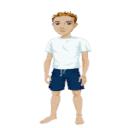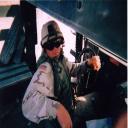Yahoo Answers is shutting down on May 4th, 2021 (Eastern Time) and beginning April 20th, 2021 (Eastern Time) the Yahoo Answers website will be in read-only mode. There will be no changes to other Yahoo properties or services, or your Yahoo account. You can find more information about the Yahoo Answers shutdown and how to download your data on this help page.
Trending News
What is the best way to train?
my brand new puppy? Just got her. She is about 8 weeks old, and the man we got her from said she was a blue heeler/border collie mix. This is my first dog, and would prefer to know more about her breed(s) so that I can train her with her natural inclinations. Any tips, advice or pointers toward good reference material would be greatly appreciated! I already have a crate for her, and plan to do the crate training. Any pointers there would be great, too.
9 Answers
- 1 decade agoFavorite Answer
The single most important aspect of dog and puppy training is that you reward and praise your dog or puppy each and every time she does the right thing. For example: praise her when she chews her own toys instead of the couch or eliminates outside instead of in the house. The more time you spend with your puppy or dog, the quicker and easier it will be to train her.
The key to house training is to establish a routine that increases the chances that your dog will eliminate in the right place in your presence, so that she can be praised and rewarded; and decreases the chances that your dog will eliminate in the wrong place so that she will not develop bad habits.
It is important that you make provisions for your dog when you are not home. Until your dog is house trained, she should not be allowed free run of your house. Otherwise, she will develop a habit of leaving piles and puddles anywhere and everywhere. Confine her to a small area such as a kitchen, bathroom or utility room that has water/stain resistant floors. Confinement is NOT crate training.
Crate training can be an efficient and effective way to house train a dog. Dogs do not like to soil their resting/sleeping quarters if given adequate opportunity to eliminate elsewhere. Temporarily confining your dog to a small area strongly inhibits the tendency to urinate and defecate. However, there is still a far more important aspect of crate training.
If your dog does not eliminate while she is confined, then she will need to eliminate when she is released, i.e., she eliminates when you are present to reward and praise her.
Be sure to understand the difference between temporarily confining your dog to a crate and long term confinement when you are not home. The major purpose of confinement when your are not home is to restrict mistakes to a small protected area. The purpose of crate training is quite the opposite. Short term confinement to a crate is intended to inhibit your dog from eliminating when confined, so that she will want to eliminate when released from confinement and taken to an appropriate area. Crate training also helps teach your dog to have bladder and bowel control. Instead of going whenever she feels like it, she learns to hold it and go at convenient scheduled times.
Crate training should not be abused, otherwise the problem will get drastically worse. The crate is not intended as a place to lock up the dog and forget her for extended periods of time. If your dog soils her crate because you left her there too long, the house training process will be set back several weeks, if not months.
Your dog should only be confined to a crate when you are at home. Except at night, give your dog an opportunity to relieve herself every hour. Each time you let her out, put her on leash and immediately take her outside. Once outside, give her about three to five minutes to produce. If she does not eliminate within the allotted time period, simply return her to her crate. If she does perform, then immediately reward her with praise, food treats, affection, play, an extended walk and permission to run around and play in your house for a couple of hours. For young pups, after 45 minutes to an hour, take her to her toilet area again. Never give your dog free run of your home unless you know without a doubt that her bowels and bladder are empty.
During this crate training procedure, keep a diary of when your dog eliminates. If you have her on a regular feeding schedule, she should soon adopt a corresponding elimination schedule. Once you know what time of day she usually needs to eliminate, you can begin taking her out only at those times instead of every hour. After she has eliminated, she can have free, but supervised, run of your house. About one hour before she needs to eliminate (as calculated by your diary) put her in her crate. This will prevent her from going earlier than you had planned. With your consistency and abundance of rewards and praise for eliminating outside, she will become more reliable about holding it until you take her out. Then the amount of time you confine her before her scheduled outing can be reduced, then eliminated.
If you ever find an accident in the house, just clean it up. Do not punish your dog. All this means is that you have given her unsupervised access to your house too soon. Until she can be trusted, don't give her unsupervised free run of your house. If mistakes and accidents occur, it is best to go back to the crate training. You need to more accurately predict when your dog needs to eliminate and she needs more time to develop bladder and bowel control.
We're talking about crate training right now at http://www.petownerforum.com/
Source(s): http://www.perfectpaws.com/crt.html - Mike SLv 41 decade ago
Well, every dog is the same when you wanna train it. Get yourself a good trainer and enroll into a puppy school to learn the basics but really start now.
People sound too cocky when they offer advice here but here's mine, take it or leave it.
Dogs are cute but are masters of manipulation if they think that they can get attention whenever they want it. You just got a new puppy and she'll be your main focus, please dont let her know that. My puppy is still my main focus but i dont make it apparent to him. When he comes up to me for a pat i ignore him, makes him realise he can't get what he wants when he wants it (attention seeking), when he's sitting down nicely i call him over or go up and sit next to him and give him all the love in the world.
Have dinner before her, walk through doors before her, low key entrances and exits (dont give her a big HELLO when you come home otherwise she'll think she's your priority and will grow an extremely big head)
Crate training also indirectly offers this, while the dog is in its crate it is left whether it wants attention or not, thus also a good method of basic training.
Dont get heart broken if your dog is crying when you leave her. It will happen alot as she is a puppy and it's something that she'lll very quickly get over if you dont nurture her at this time and completely ignore her.
See a trainer and they'll point you in the right direction.
Also using treats as incentives and as positive reinforcements are definately the way to go
Good luck with your new puppy, hope i didnt sound too cocky. You'll get a range of different responses.
- Anonymous1 decade ago
Well, every dog is the same when you wanna train it. Get yourself a good trainer and enroll into a puppy school to learn the basics but really start now.
People sound too cocky when they offer advice here but here's mine, take it or leave it.
Dogs are cute but are masters of manipulation if they think that they can get attention whenever they want it. You just got a new puppy and she'll be your main focus, please dont let her know that. My puppy is still my main focus but i dont make it apparent to him. When he comes up to me for a pat i ignore him, makes him realise he can't get what he wants when he wants it (attention seeking), when he's sitting down nicely i call him over or go up and sit next to him and give him all the love in the world.
Have dinner before her, walk through doors before her, low key entrances and exits (dont give her a big HELLO when you come home otherwise she'll think she's your priority and will grow an extremely big head)
Crate training also indirectly offers this, while the dog is in its crate it is left whether it wants attention or not.
See a trainer and they'll point you in the right direction.
Also using treats as incentives and as positive reinforcements are definately the way to go
Good luck with your new puppy, hope i didnt sound too cocky. You'll get a range of different responses gfood luck and hope u trained ur puppy
- Anonymous5 years ago
Train Kept a Rollin. I'm an Aerosmith fan. But you forgot Crazy Train! Edit: Okay, since someone said Crazy Train already, I'll add Love Train by Wolfmother.
- How do you think about the answers? You can sign in to vote the answer.
- EMTPrincessLv 51 decade ago
clicker training, when done the way its supposed to be done, is amazing. we just started clicker training with our puppy (attention span of literally 2 seconds two weeks ago) and she is now starting to pay attention a lot longer. the basics behind clicker training is the clicker signifies to the dog it is doing what is wanted. the first few sessions you start out click, treat. click, treat. click, treat. you click when the dog makes eye contact with you. after several times of this you click, second pause, treat, repeat lengthening the pause in between over time. **treat is not always food, treat is also praise and petting** from there you can begin training your dog to do what you want - ie sit, then when the dog sits you click. hand signals are a wonderful idea as well. when you do your hand signals make sure you don't do them in front of your body do them to the side so that the dog is able to see them from across the room - you eventually should be able to make eye contact with your dog, give the signal for lay from the other side of the room or yard or whatever and the dog does so. also make sure your signals are distinct so the dog does not get mixed up in what you are asking for.
as far as breed goes her natural inclinations will be towards herding - borders are great sheep dogs (ever see the movie Babe?) - agility would most likely be something she would be good at - jumps, A frames, tilt boards, weave poles, etc. if you want more info on clicker training or hand signals or whatever feel free to email me.....
Source(s): Nan - professional dog trainer from over 20 years, with show experience and awards - Anonymous1 decade ago
Cute! Alright, here is the deal. The best way to teach puppies is the simple praise/reprimend way.
For Example: They do something good, such as go to the bathroom outside, you shower them with verbal praises and maybe a piece of kibble. If they do something bad like pee in the house, you make sure they face what they did and say no multiple times, and then rush them outside.
Most dogs, (in your case you are lucky - collies and blue heelers are quite smart), learn quickly this way that if they do a certain action, they get in trouble for it.
Good books to look at would be anything from the AKC, and most puppy books found at local bookstores or libraries. I personally like the AKC Puppy Guide.
Here is a whole list of credible books:
http://www.workingdogs.com/book033.htm
Another way, although I would not recommend it unless as a last resort, is clicker training. Reference materials for it are easy to find online.
- Agility ManLv 61 decade ago
1. Make every moment a training or teaching moment. Just don't let them run on too long because puppies have minimal attention spans. Get in the habit of carrying some kibble in your pocket. Call your dog's name--when she comes--treat. Look for opportunities to catch the dog doing something right. In fact, you can take one meal and just use it as treats (so there is one bowl in the morning and the second meal gets spread over the day as rewards for responding the right way).
2. Start small. Don't just shove the dog in a crate. Leave the gate open and put a toy in or a food dish and let the puppy wander in and out a couple of times first. Do things in small steps. Reward the dog for responding to her name.
3. Look for a good resource. The Monks of New Skete have a couple of books out plus a video series that are good, especially with puppies in mind. But there are plenty of other sources out there just as good. Find something and rely on it regularly.
4. Socialize your puppy constantly. Introduce it to new sounds, people, sights (put it in the cart and take it to Petsmart) and after it sees a new sight or sound, comfort it (so the puppy realizes that when that really loud machine goes by, it doesn't have to be scary).
5. There is an incredible series of articles (6 of them) running through 2007 in Clean Run Magazine. CR is specific to agility (and your dog is too young to do that right now). But the articles are written by Nancy Gyes who is a highly respected trainer and the coach of the US National team at the FCI Agility World Competition. The articles by Nancy are about a new border collie puppy she and her husband got at 8 weeks and how they work with it (housetraining, recalls and obedience, coordination, building confidence, socialization, focus and control). If your library doesn't get Clean Run or you can't find a local agility competitor then it would be worth it for you to go to the website and order one back magazine, read just one of the articles in the series and decide if you want to buy the rest. But I can tell you--the next puppy I get, I'm using those articles as my bible--they're great!
6. Clicker training is actually highly regarded as a means of training animals. It got it's official start at Sea World training dolphins. It's been used with cats, horses and a bunch of other animals. It is widely used by most experienced dog trainers. It's easy to use. I highly recommend that you look into it because it's especially effective with a puppy.
7. Do NOT stick a puppy's nose in something (her poop, the shoe she chewed up, whatever) and say "no" a lot. Puppies in particular have ADD--they could poop on the floor and 2 seconds later would go "huh--I wonder what that great smell is--hey, who did this on the floor?" When you yell and stick their nose in something, all they get is "my owner is someone to be scared of--they scream at me. Maybe the next time they call for me it may not be safe for me to come because they'll just yell at me."
8. You've got a mixed breed and I don't know blue heelers very well. But border collies are extremely smart dogs who love to work. You should be thinking about what you're going to do to both work her physically and challenge her mentally. Eventualy agility or other performance sports could be good. Things like flyball, rally-O, or teaching her 70--80 tricks. You won't be able to do many of the performance sports until she's a year old. But you'll want to do puppy kindergarden as soon as she's eligible, then obedience I and obedience II. A border collie absolutely needs to work and needs mental engagement or they become bored and then destructive (chewing shoes, turning over wastebaskets). There's an old joke that is adapted to dog breeds: how many border collies does it take to change a light bulb? The answer: just one, and then she'll replace any wiring that isn't up to code, sweep up the mess and bark at you to ask why you haven't taken her out on a walk yet. BC's are great dogs--but not if you want to lounge around a lot or expect the dog to enjoy an idle life.
Source(s): Karen Pryor's site on clicker training--the best resource for this on the web: www.clickertraining.com The Clean Run Magazine site where you could find out about back issues and see the article index (the article series refers to "The Spye Kids" by Nancy Gyes): www.cleanrun.com Here's a great website resource (it's a bit dated but still rich in info) on dogs, especially puppies: http://www.uwsp.edu/psych/dog/lib-puppy.htm - 1 decade ago
Visit my Yahoo 360 Blog for a wealth of info on dog behavior and training.
Professional training is not easy to beat.






